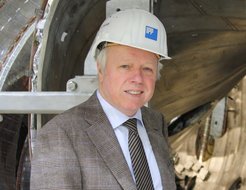New Technical Director for ITER
Dr. Rem Haange, Technical Director at IPP Greifswald, to head ITER construction in 2011

Remmelt Haange has already been involved in the construction of various large-scale fusion devices. As Technical Director he is at present in charge of construction of Wendelstein 7-X at IPP’s Greifswald branch. Previously, he was concerned with the planning and modification of the JET joint European experiment and with the planning of ITER.
Dr. Remmelt Haange, born in 1944 at Anloo in the Netherlands, studied mechanical engineering and did his PhD at RWTH in Aachen. From 1973 he worked on the Dragon high-temperature reactor, an OECD project at Winfrith in England. He then established a work group for the multinational High Temperature Materials Programme at Wimborne, England. In 1979 he changed to fusion research in the service of Euratom and headed a group for planning the plasma heating for the JET (Joint European Torus) project. Eight years later he took charge of the Fusion Technology Division; from 1992 he was responsible for management of the extensive modification of the JET device and for a team of about 600 members of staff. In 1993 he joined the Japanese ITER planning group at Naka as head of the Nuclear Technologies Division; in 2003 he was appointed head of site. Then, in 2005, he joined Max Planck Institute for Plasma Physics at Greifswald, where he has since been responsible as Technical Director for construction of the Wendelstein 7-X stellarator. The technical challenges presented to assembly of this device by its asymmetric geometry are enormous. “As a tokamak ITER is, admittedly, of simpler shape”, states Dr. Haange, “but the device is much bigger and the seven parties to the project are scattered all over the world”. This huge objective can, however be solved, now that the baseline for ITER and the goals of the device have been confirmed: “We now have to make sure that we meet these milestones. This fascinating, world-spanning project must become a success”.
Background:
The objective of fusion research is to develop a power plant that, like the sun, derives energy from fusion of atomic nuclei. The fuel used is a low-density hydrogen plasma. To ignite the fusion fire the plasma has to be confined in magnetic fields and heated to temperatures of over 100 million degrees. The physical principles are being investigated in detail at Max Planck Institute for Plasma Physics in Garching and Greifswald. Results obtained there also went into the planning of the ITER international test reactor. This large-scale device is to show that an energy-yielding fusion fire is possible.
